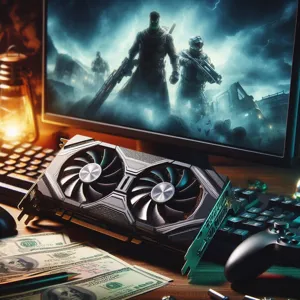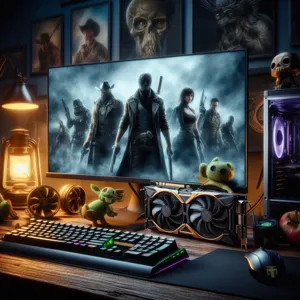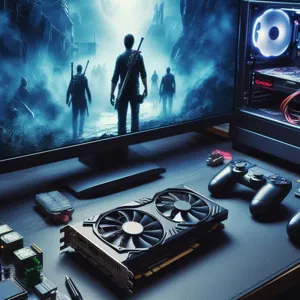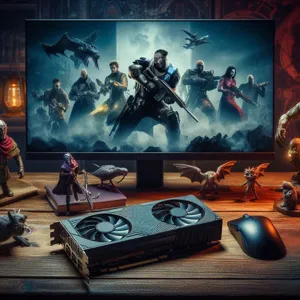As the world of gaming continues to evolve at a breathtaking pace, virtual reality has emerged as a groundbreaking frontier, offering immersive experiences that transport players into entirely new realms.
However, to truly harness the magic of VR, you need the right tools, and at the heart of any powerful gaming rig lies a robust graphics card. Choosing the perfect graphics card for your PC gaming needs can be an overwhelming task, with a myriad of options available that vary in performance, price, and features. In this comprehensive guide, we’ll help you navigate the complex landscape of graphics cards, breaking down essential specifications, performance benchmarks, and compatibility considerations. whether you’re a seasoned gamer looking to upgrade your setup or a newcomer eager to dive into the exhilarating world of virtual reality, this post will empower you to make an informed decision that will elevate your gaming experience to new heights. Prepare to unlock the full potential of virtual reality as we guide you through the intricacies of selecting the ideal graphics card for your PC!
1. Introduction to Virtual Reality and Its Graphics Requirements
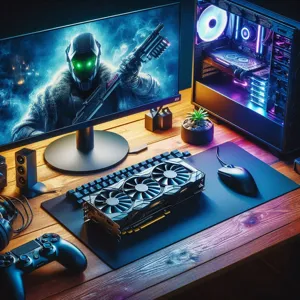
As the realm of gaming evolves, virtual reality (VR) has emerged as a pioneering frontier, offering players an immersive experience that transcends the traditional boundaries of gameplay. Imagine stepping into a digital universe where you can physically interact with your environment, explore breathtaking landscapes, and engage in heart-pounding adventures as if you were truly there. However, to fully unlock the potential of VR, a robust graphics card is essential.
Graphics cards are the beating heart of any gaming rig, and their significance is magnified in the world of virtual reality. Unlike conventional gaming, where a good frame rate and resolution may suffice, VR demands an extraordinary level of performance. The visuals must be rendered in real-time with low latency to prevent motion sickness and ensure a fluid experience. High frame rates—ideally 90 FPS or higher—are crucial, as they help maintain immersion and responsiveness while reducing the chance of discomfort.
Moreover, the graphics card must support advanced technologies such as ray tracing and variable rate shading, which enhance realism and detail in VR environments. As you navigate through vibrant worlds filled with dynamic lighting and intricate textures, a powerful GPU ensures that these elements are not just visual flourishes but integral parts of your gaming experience.
In this guide, we will delve into the key considerations for selecting the perfect graphics card for VR gaming. From understanding the specifications that matter most, to evaluating compatibility with VR headsets and ensuring future-proofing for upcoming titles, we’ll equip you with the knowledge needed to make an informed decision. Whether you’re a seasoned gamer looking to upgrade your setup or a newcomer eager to dive into the virtual realm, choosing the right graphics card is the first step towards unleashing the full potential of virtual reality.
2. Understanding the Importance of a Graphics Card in VR Gaming
When it comes to virtual reality (VR) gaming, the graphics card is the beating heart of your PC setup, dictating not only the quality of the visual experience but also the overall performance and responsiveness of your VR environment. Unlike traditional gaming, where a good frame rate is essential, VR gaming demands an even higher standard. The graphics card must deliver ultra-smooth frame rates—ideally 90 frames per second or more—across two screens (one for each eye) to prevent motion sickness and ensure an immersive experience.
A powerful graphics card processes complex 3D environments, realistic textures, and intricate lighting effects that are crucial for creating lifelike virtual worlds. It handles the intensive computational tasks required to render images at high resolutions, which is particularly important in VR where even the slightest lag can break the illusion of being in another world. With VR, you’re not just viewing the game; you’re inhabiting it, and a subpar graphics card can shatter that immersion.
Moreover, the right graphics card enhances features such as anti-aliasing, which smooths out jagged edges, and higher refresh rates, which minimize motion blur. These elements are vital for maintaining visual fidelity and clarity in fast-paced action scenes. As you navigate through virtual environments, whether it’s exploring alien planets or battling mythical creatures, a high-quality graphics card ensures that every detail pops, making your experience both breathtaking and engaging.
In addition to performance, compatibility is another critical aspect to consider. Not all graphics cards support all VR headsets, so it’s essential to check specifications and ensure that your chosen card pairs seamlessly with your VR hardware. Investing in a top-tier graphics card may seem daunting, but it’s a crucial decision that will dramatically impact your VR gaming adventures. By understanding the pivotal role of the graphics card, you can make an informed choice that sets the stage for countless hours of immersive gameplay.
3. Key Specifications to Consider When Choosing a Graphics Card
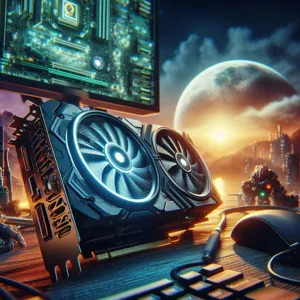
When it comes to selecting the ideal graphics card for your virtual reality (VR) gaming experience, understanding the key specifications is essential. The right graphics card can significantly enhance your immersion in virtual worlds, making it crucial to be well-informed about what to look for.
**1. GPU Architecture:** The architecture of the GPU (Graphics Processing Unit) plays a pivotal role in performance. Modern GPUs, such as NVIDIA’s Ampere or AMD’s RDNA, offer advanced features like real-time ray tracing and improved energy efficiency. These architectures are designed to handle the demanding graphics of VR, ensuring smoother frame rates and more realistic visuals.
**2. VR-Ready Performance:** Not all graphics cards are created equal when it comes to VR. Look for cards that are explicitly labeled as “VR-ready.” This designation often suggests that the card has the processing power to render high-resolution images with minimal latency, which is vital for immersive VR experiences. Cards such as the NVIDIA GeForce RTX 3060 and AMD Radeon RX 6700 XT are excellent choices for VR gaming.
**3. Memory (VRAM):** The amount of VRAM (Video Random Access Memory) is another critical factor. For VR gaming, a minimum of 6GB of VRAM is recommended, although 8GB or more is ideal for high-resolution textures and complex scenes. More VRAM allows your graphics card to store detailed information about the virtual environment, leading to sharper visuals and a smoother experience.
**4. Frame Rate and Resolution:** High frame rates are crucial in VR to reduce motion sickness and enhance realism. Aim for a graphics card that can consistently deliver 90 frames per second (FPS) or higher in VR environments. Additionally, consider the resolution of the VR headset you’re using; a higher resolution headset will require a more powerful graphics card to ensure optimal performance.
**5. Cooling Solutions:** VR gaming can generate considerable heat, so an effective cooling system is necessary to maintain performance and longevity. Look for graphics cards with robust cooling solutions, such as larger heatsinks and multiple fans, to ensure they can handle extended gaming sessions without throttling.
**6. Connectivity Options:** Ensure that the graphics card you choose has the necessary ports to connect to your VR headset. Most modern headsets utilize HDMI or DisplayPort, so verify that your selected card includes these connections, along with any additional ports you may need for other peripherals.
By paying close attention to these key specifications, you can confidently choose a graphics card that will not only elevate your gaming experience but also unlock the full potential of virtual reality, allowing you to delve into immersive worlds with stunning graphics and seamless performance.
4. The Role of VR-Ready Graphics Cards
When it comes to virtual reality gaming, the importance of a VR-ready graphics card cannot be overstated. This vital component acts as the backbone of your immersive experience, ensuring that graphics are rendered smoothly and efficiently. Unlike traditional gaming, where a solid graphics card can suffice, VR demands a higher level of performance due to its unique requirements.
A VR-ready graphics card is designed to handle the intense workload that virtual reality environments impose. These cards possess higher pixel counts, faster frame rates, and enhanced processing power, all essential for creating the lifelike visuals that VR experiences strive to deliver. Imagine being transported to a fantastical world where every detail, from the texture of a dragon’s scales to the shimmer of sunlight filtering through the leaves, feels incredibly real. This level of immersion hinges heavily on the capabilities of your graphics card.
Moreover, VR gaming often requires rendering two separate images simultaneously—one for each eye—creating a stereoscopic effect that enhances depth perception. This means that your graphics card must not only excel in raw performance but also be optimized for low latency and high refresh rates to prevent motion sickness and maintain a seamless experience. Look for cards that support technologies like NVIDIA’s G-SYNC or AMD’s FreeSync, as these features can significantly improve visual fluidity by synchronizing the frame rates between your graphics card and VR headset.
In addition to performance specifications, compatibility is another critical factor when selecting a VR-ready graphics card. Ensure that the card you choose is compatible with your VR headset, whether it’s the Oculus Rift, HTC Vive, or another brand. Check for the required ports—such as HDMI or DisplayPort—and confirm that your power supply can support the card’s wattage needs.
Ultimately, investing in a quality VR-ready graphics card is essential for unlocking the full potential of virtual reality gaming. It not only enhances your overall experience but also sets the stage for future advancements in VR technology, allowing you to enjoy the latest games and applications as they evolve. Whether you’re battling fierce foes in a fantasy realm or exploring the depths of space, the right graphics card will propel you into a world where the line between reality and imagination blurs beautifully.
5. Comparing NVIDIA and AMD Graphics Cards for VR

When it comes to selecting the ideal graphics card for an immersive virtual reality experience, the age-old rivalry between NVIDIA and AMD comes into play. Both companies offer impressive options, but understanding their differences can significantly impact your VR gaming journey.
**NVIDIA Graphics Cards** are often praised for their superior performance and advanced features tailored for VR. With their latest line of GeForce RTX cards, NVIDIA introduces real-time ray tracing, which enhances lighting effects and creates lifelike environments that are crucial for VR immersion. Their Deep Learning super Sampling (DLSS) technology is another game-changer, allowing for higher frame rates without compromising visual quality. This capability is particularly beneficial in VR, where maintaining a smooth frame rate is essential to prevent motion sickness and ensure an engaging experience. Furthermore, NVIDIA’s G-SYNC technology helps eliminate screen tearing, providing a smoother and more fluid gaming experience, which is vital when you’re fully enveloped in a virtual world.
On the other hand, **AMD Graphics Cards** have made significant strides in the VR market, particularly with their Radeon RX series. AMD cards are known for delivering excellent performance at competitive price points, making them an appealing option for budget-conscious gamers. While they may not yet match NVIDIA’s ray tracing capabilities, recent advancements with AMD’s RDNA architecture have improved their efficiency and performance in demanding VR scenarios. Additionally, AMD’s FreeSync technology offers a similar solution to G-SYNC, reducing screen tearing and stuttering, which is crucial for maintaining the illusion of reality in VR.
Ultimately, the choice between NVIDIA and AMD comes down to your specific needs and budget. If you prioritize cutting-edge technology and are willing to invest more for the best possible VR experience, NVIDIA might be the way to go. However, if you’re looking for solid performance without breaking the bank, AMD’s offerings provide excellent value. As you weigh your options, consider not just the performance stats but also the games you plan to play, the level of detail you desire, and your system’s overall compatibility. With the right graphics card, you can unlock the full potential of virtual reality gaming and dive into experiences that are truly out of this world.
6. Recommended Graphics Cards for Different Budgets
When it comes to virtual reality gaming, the graphics card is your engine, propelling you into rich, immersive worlds and ensuring a smooth, realistic experience. Selecting the right GPU is crucial, especially as VR demands high performance to render lifelike environments without lag or distortion. Here’s a breakdown of recommended graphics cards tailored to various budgets, helping you make an informed decision without breaking the bank.
**Entry-Level: Nvidia GeForce GTX 1660 Super**
For beginners who want to dip their toes into VR without a hefty investment, the Nvidia GeForce GTX 1660 Super is an excellent choice. Priced affordably, this card delivers solid performance for most VR titles, allowing you to enjoy experiences like “Beat Saber” or “Job Simulator” without compromising on quality. With its ability to handle 1080p gaming smoothly, it’s a great entry point for those just starting their VR journey.
**Mid-Range: AMD Radeon RX 6700 XT**
Moving up in budget, the AMD Radeon RX 6700 XT shines as a powerhouse for mid-range gamers. Offering excellent performance at 1440p, this card excels in rendering detailed graphics and high frame rates, making it ideal for more demanding VR games. With its competitive pricing and robust features, it strikes a great balance between performance and affordability, ensuring you stay immersed in the virtual world without hiccups.
**High-End: Nvidia GeForce RTX 3080**
For serious gamers ready to invest in top-tier performance, the Nvidia GeForce RTX 3080 is a game-changer. This powerhouse card boasts incredible ray tracing capabilities, allowing you to enjoy breathtaking visuals and lighting in VR. With its ability to handle 4K gaming seamlessly, the RTX 3080 elevates your VR experience to a whole new level, making it perfect for titles that push the boundaries of graphics and performance.
**Ultimate Performance: Nvidia GeForce RTX 4090**
If budget is no object and you want the ultimate VR experience, look no further than the Nvidia GeForce RTX 4090. This monster of a graphics card is designed for enthusiasts who demand the very best. Whether you’re exploring vast open worlds in “Half-Life: Alyx” or engaging in visually intensive multiplayer experiences, the RTX 4090 delivers unparalleled performance, ensuring a buttery-smooth experience with stunning visuals that will leave you breathless.
By considering your budget and the type of VR experiences you want to enjoy, you can choose the perfect graphics card that aligns with your gaming aspirations. Investing in the right GPU not only enhances your gameplay but also ensures you’re future-proofed for the exciting developments in the ever-evolving world of virtual reality.
7. How to Balance Performance and Price
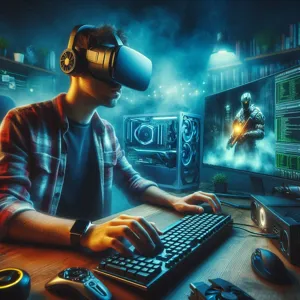
When it comes to selecting the right graphics card for your virtual reality gaming experience, finding the sweet spot between performance and price can feel like walking a tightrope. The right balance is crucial not just for your wallet, but also for ensuring a smooth and immersive gaming experience. Here are some key considerations to help you navigate this delicate equilibrium.
First, define your gaming needs and expectations. Are you an avid gamer seeking the latest titles at ultra settings, or do you prefer casual gaming with decent quality? Understanding your requirements will guide your choices significantly.
Next, familiarize yourself with the current market trends and specifications. High-end graphics cards often come with impressive performance metrics, but they also carry hefty price tags. Check benchmarks for popular VR titles to determine which cards consistently deliver high frame rates and responsiveness without breaking the bank. Websites like Tom’s Hardware and TechSpot often provide detailed comparisons that can help you identify cards that offer the best performance for your budget.
Another essential factor is to consider future-proofing your investment. While it may be tempting to opt for a mid-range card to save money, consider the longevity of the product and your gaming aspirations. Investing a little more upfront in a higher-tier card can save you from needing an upgrade sooner than expected, especially as games evolve and become more demanding.
Don’t forget to factor in additional costs, such as power supply requirements and cooling solutions. A more powerful graphics card may require a more robust power supply unit or additional cooling mechanisms to maintain optimal performance.
Lastly, keep an eye out for sales, refurbished units, or previous-generation models. Many gamers find excellent deals on slightly older graphics cards that still provide exceptional performance for VR gaming without the premium price tag associated with the latest releases. Websites like Newegg and Micro Center often have sales that can help you score a great deal.
By weighing these considerations and researching thoroughly, you can confidently choose a graphics card that balances performance and price, ensuring your virtual reality adventures are not only thrilling but also cost-effective.
8. The Impact of VR Technology on Graphics Card Performance
As you delve into the immersive world of virtual reality (VR), one of the most critical components that can make or break your experience is the graphics card. VR technology places unique demands on hardware, requiring not only high-resolution visuals but also lightning-fast frame rates to ensure smooth and seamless interactions. Unlike traditional gaming, where a slight dip in performance might go unnoticed, VR is unforgiving. A laggy experience can lead to discomfort, motion sickness, or even disorientation, pulling you out of the captivating worlds that VR has to offer.
When evaluating graphics cards for VR, consider the resolution and refresh rate of your VR headset. Many of today’s high-end headsets, like the Oculus Quest 2 or the Valve Index, boast resolutions that can rival 4K displays, making it essential to choose a graphics card capable of rendering complex environments with stunning clarity. Furthermore, VR experiences often require frame rates of at least 90 frames per second or more, as even a momentary drop to lower rates can disrupt the fluidity of motion, impacting your overall experience.
Moreover, VR introduces the challenge of rendering 3D environments from two slightly different perspectives (one for each eye). This means that the demands on a graphics card are significantly higher than those for standard gaming. A powerful GPU not only ensures the graphics are visually appealing but also enhances the realism of the environment, allowing for more immersive gameplay where every detail, from the rustling of leaves to the flicker of lights, feels tangible.
In the realm of VR, it’s also crucial to consider the technology behind the graphics card. Features like ray tracing and variable rate shading can elevate your experience, providing more lifelike lighting, shadows, and reflections. These enhancements contribute to a more believable virtual world, making your adventures feel even more real.
Lastly, bear in mind that VR gaming can be resource-intensive. It’s not just about having a powerful graphics card; it’s about ensuring that your entire system is well-balanced. A high-end GPU paired with an outdated CPU or insufficient RAM may limit performance and lead to bottlenecks, affecting your gameplay experience.
In summary, the choice of graphics card plays a pivotal role in the quality of your VR experience. To truly unlock the potential of virtual reality, invest time in understanding the specifications and capabilities of the graphics cards available, ensuring they align with the demands of your chosen VR headset. By doing so, you’ll not only enhance your gameplay but also immerse yourself in captivating worlds like never before.
9. Cooling Solutions for High-Performance Graphics Cards
When delving into the world of high-performance graphics cards, one cannot overlook the crucial aspect of cooling solutions. As you push your graphics card to the limits during intense gaming sessions or VR experiences, it generates significant heat. Without proper cooling, this heat buildup can lead to thermal throttling, where your GPU slows down to prevent damage, resulting in a subpar gaming experience.
Modern graphics cards come equipped with a variety of cooling options, and understanding these can make all the difference in maintaining optimal performance. Air cooling is the most common method, utilizing fans and heatsinks to dissipate heat. High-quality air coolers often feature multiple fans, larger heatsinks, and advanced designs to maximize airflow. Brands like ASUS and MSI offer models with innovative fan placements and RGB lighting, all while ensuring effective heat management.
For those seeking even more efficient cooling, liquid cooling solutions present an attractive alternative. Liquid cooling systems can handle higher temperatures and provide quieter operation. These setups often include a radiator, pump, and water block, circulating coolant to absorb heat from the GPU. Custom water cooling loops offer enthusiasts the flexibility to fine-tune their systems for peak performance but can require more technical knowledge and maintenance.
It’s also vital to consider case airflow. A well-ventilated case enhances the effectiveness of your cooling solution, allowing for better heat dissipation. Investing in quality case fans, strategically positioned to create an optimal airflow path, can significantly improve the cooling performance of your entire setup.
In summary, selecting the right cooling solution for your graphics card is paramount to unlocking the full potential of your PC gaming experience. Whether you lean towards the simplicity of air cooling or the efficiency of liquid cooling, ensure that your choice aligns with your gaming needs and hardware configuration. A well-cooled graphics card not only enhances performance but also extends the lifespan of your investment, allowing you to immerse yourself in the stunning worlds of virtual reality and high-resolution gaming without a hitch.
10. How to Upgrade Your PC for Optimal VR Experience
Upgrading your PC for an optimal virtual reality (VR) experience is an exhilarating venture, one that can dramatically enhance your immersion in digital worlds. To navigate this technological journey, you’ll need to focus on several core components that influence VR performance—primarily the graphics card, processor, RAM, and storage.
**1. Selecting the Right Graphics Card:**
The graphics card is the heart of your VR setup. It determines how smoothly your virtual worlds will render and how lifelike the graphics can be. Look for cards that are VR-ready, such as NVIDIA’s GeForce RTX series or AMD’s Radeon RX series. Pay attention to the specifications: a minimum of 6GB of VRAM is recommended to handle the demands of high-resolution textures and complex environments. Additionally, consider the card’s compatibility with your VR headset—some headsets may have specific requirements regarding supported GPUs.
**2. Upgrading Your CPU:**
Your CPU, or central processing unit, is the brain of your computer and plays a crucial role in how well it can handle VR. A powerful CPU will ensure that it can keep up with the fast-paced demands of virtual environments, particularly when it comes to simulating physics and rendering complex scenes. Look for multi-core processors from Intel or AMD that boast high clock speeds; models like the Intel Core i7 or AMD Ryzen 7 are popular choices among gamers seeking peak performance.
**3. Increasing RAM:**
While VR isn’t solely dependent on RAM, having sufficient memory is essential for smooth gameplay. A minimum of 16GB is recommended for VR gaming, as this allows for multitasking without performance dips. If you’re running resource-intensive applications alongside your VR games or simulations, consider upgrading to 32GB for an even more seamless experience.
**4. Fast Storage Solutions:**
Finally, don’t overlook the importance of storage. Traditional hard drives (HDDs) can create latency issues, leading to longer loading times and potentially disrupting the immersive experience. Opt for solid-state drives (SSDs), which can dramatically reduce loading times and provide faster data access speeds. This is especially beneficial for VR, where every millisecond counts and seamless transitions enhance immersion.
**5. Ensuring Proper Cooling and Power Supply:**
Lastly, as you upgrade these components, ensure that you have adequate cooling solutions in place to prevent overheating during intense gaming sessions. A reliable power supply unit (PSU) is also critical; it should provide enough wattage to support your upgraded components. Look for a PSU with a capacity that exceeds the combined requirements of all your hardware.
By focusing on these upgrades, you can transform your PC into a powerhouse, equipped to deliver an optimal and immersive virtual reality experience. As you delve into the thrilling landscapes of VR, remember that every component plays a vital role in crafting the ultimate gaming adventure.
11. Software and Drivers: Keeping Your Graphics Card Updated
When it comes to maximizing the performance of your graphics card, one of the most crucial yet often overlooked aspects is the software and drivers that power it. Just as a high-performance sports car requires regular maintenance to run at its best, your graphics card thrives on the latest updates and optimizations provided by its drivers. Keeping these up to date not only ensures your card can handle the latest games and applications but also enhances stability and performance, particularly in the demanding realm of virtual reality.
Manufacturers like NVIDIA and AMD continuously release driver updates that fine-tune performance, fix bugs, and introduce new features that can drastically improve your gaming experience. For instance, a recent driver update might optimize performance for a new VR title, enhancing frame rates and reducing latency, both critical for immersive gameplay. Regularly checking for updates should be part of your routine, and both NVIDIA and AMD provide software tools that make this process seamless. NVIDIA’s GeForce Experience and AMD’s Radeon Software Adrenalin Edition offer one-click updates and even game optimization settings tailored to your hardware.
Moreover, the right software can help you monitor your graphics card’s performance in real-time. Applications like MSI Afterburner or GPU-Z allow you to track temperature, usage, and clock speeds, ensuring your card operates within safe parameters. This proactive approach can also alert you to potential issues before they become significant problems, ensuring that your gaming rig remains in top shape.
Lastly, don’t forget about the importance of compatibility with the software you intend to use for gaming. Some VR titles may require specific driver versions to function correctly, so it’s always wise to check the game’s requirements and recommended specifications. By prioritizing software and driver updates, you not only extend the lifespan of your graphics card but also unlock its full potential, enhancing your virtual reality adventures in ways you never thought possible.
12. Benchmarking Graphics Cards for VR Performance
When it comes to virtual reality gaming, the performance of your graphics card can make or break your experience. Benchmarking graphics cards for VR performance is a crucial step in ensuring that you select the right component for your setup. VR demands a level of performance that surpasses traditional gaming due to its immersive nature and the need for smooth, high-fidelity visuals.
To begin, you’ll want to look at several key performance metrics when evaluating graphics cards. Frame rates (FPS) are paramount; a minimum of 90 FPS is generally recommended for a smooth VR experience, as anything lower can lead to motion sickness and a jarring experience. Additionally, pay attention to the card’s latency; lower latency ensures that the time between your movements and the corresponding action in the VR environment is minimal, creating a more seamless and responsive interaction.
Look for reputable benchmarks specifically focused on VR testing. Websites and forums dedicated to VR gaming often conduct comprehensive tests on various graphics cards, allowing you to compare performance across different titles and applications. Key titles like “Half-Life: Alyx” or “Beat Saber” can serve as excellent benchmarks since they are optimized for VR and can provide insights into how well a graphics card handles detailed graphics and rapid motion.
Moreover, consider the resolution and refresh rate of your VR headset. A higher resolution headset demands more from your graphics card; thus, ensuring your chosen card can handle the additional strain is essential. For example, while an NVIDIA RTX 3060 may perform admirably at 1080p, it could struggle with the higher resolutions of headsets like the Oculus Quest 2 when operating in PC VR mode.
Lastly, keep an eye on future-proofing your investment. As VR technology continues to evolve, so too will the requirements for graphics cards. Opting for a card that not only meets today’s standards but also has the potential to handle tomorrow’s advancements will ensure that your VR experience remains cutting-edge for years to come. By thoroughly benchmarking and understanding the performance of graphics cards in the context of virtual reality, you’ll be well-equipped to make an informed decision that maximizes your gaming enjoyment.
13. Future-Proofing Your Graphics Card Choice
When investing in a graphics card for PC gaming, particularly in the realm of virtual reality, future-proofing your choice is essential. The rapid pace of technological advancement means that today’s cutting-edge components can quickly become outclassed by newer, more powerful options. To ensure that your system remains capable of handling the latest VR titles and innovations, consider a few key factors when making your selection.
First, look for a graphics card that exceeds the minimum requirements for the most demanding VR games currently available. This often means opting for models that offer higher memory bandwidth and processing power. Cards equipped with advanced architectures, such as NVIDIA’s Ampere or AMD’s RDNA 2, provide not only enhanced performance but also support for features like ray tracing and AI-driven enhancements, which are increasingly becoming standard in high-end gaming experiences.
In addition to raw power, consider the longevity of the card. research the manufacturer’s track record for driver support and updates. A graphics card that receives regular driver updates will often perform better with new game releases and can adapt to emerging VR technologies. Brands known for their solid support, like NVIDIA and AMD, often release continual updates that optimize performance and fix issues, making them a safer bet for future-proofing.
Another crucial aspect to consider is the VR headset compatibility. Ensure that the graphics card you choose is optimized for the VR headset you plan to use. Some cards offer specific features that cater to VR experiences, such as low-latency rendering and support for higher refresh rates, which significantly enhance immersion and reduce motion sickness.
Lastly, keep an eye on the evolving landscape of gaming demands. As developers push the boundaries of graphic fidelity and realism, the requirements for VR gaming will only increase. Investing in a graphics card that not only meets today’s standards but also anticipates future advancements will ensure that your gaming rig remains relevant for years to come. By choosing wisely now, you can dive into immersive virtual worlds today, while confidently preparing for the innovations of tomorrow.
14. Real-World VR Gaming Experiences: What to Expect
When stepping into the realm of virtual reality (VR) gaming, the experience is nothing short of transformative. Unlike traditional gaming, VR immerses you in richly detailed environments, allowing you to interact with digital worlds in ways you’ve only dreamed of. However, the quality of these experiences heavily relies on the power of your graphics card.
Once you don your VR headset, you’ll find yourself transported to breathtaking landscapes—whether it’s exploring the vastness of space, battling ferocious creatures in a fantastical realm, or solving intricate puzzles in surreal environments. The graphics card you choose will dictate the clarity of these visuals. A high-quality card ensures that textures are sharp, colors are vibrant, and frame rates remain smooth, which is crucial for avoiding motion sickness and enhancing your overall enjoyment.
In real-world scenarios, expect to be fully engaged: you’ll be physically moving, reaching out to grab virtual objects, and even communicating with other players in multi-user environments. Games like “Half-Life: Alyx” and “Beat Saber” showcase the potential of VR, pushing the boundaries of interaction and realism. With a robust graphics card, these experiences become seamless and lifelike, allowing you to lose yourself in the game as if you were truly there.
As you navigate this virtual landscape, anticipate the exhilarating moments that come from high-resolution graphics and rapid response times. You may find yourself dodging incoming threats or strategizing with teammates in real-time, all while the graphics card works tirelessly behind the scenes to deliver fluid motion and responsive gameplay.
Ultimately, a powerful graphics card is your ticket to unlocking the full potential of VR gaming. As you select the right one, remember that the goal is to create an experience that feels as real as possible—one that keeps you coming back for more adventures in the limitless digital universe.
15. Conclusion: Making an Informed Decision for Your VR Setup
As we wrap up our exploration of selecting the ideal graphics card for your virtual reality setup, it’s essential to remember that the right choice can significantly enhance your gaming experience. The world of VR is immersive and demanding, requiring powerful hardware to deliver stunning visuals and smooth performance. By considering factors such as compatibility, performance benchmarks, and your specific gaming needs, you can make an informed decision that aligns with your budget and expectations.
A high-quality graphics card will enable you to enjoy breathtaking graphics, minimize latency, and unlock the full potential of your VR headset. Whether you’re a casual gamer or a dedicated enthusiast, investing in a capable GPU is crucial for achieving the level of realism and interactivity that virtual reality offers. Remember to stay updated on the latest technologies and advancements in the market, as the landscape of gaming hardware is ever-evolving.
Ultimately, the perfect graphics card for your VR setup is one that not only meets the minimum requirements of your chosen headset but also provides room for growth and future upgrades. Take your time to research, compare options, and read reviews to find the card that complements your gaming style. With the right GPU, you’ll be well-equipped to delve into incredible virtual worlds and enjoy experiences that are truly beyond reality. Happy gaming!
As we conclude our exploration of choosing the perfect graphics card for unlocking the immersive world of virtual reality gaming, we hope you now feel empowered to make an informed decision that enhances your gaming experience. The right graphics card can transform your VR adventures, delivering stunning visuals and smooth performance that make every moment feel lifelike. Remember to consider factors like compatibility, performance benchmarks, and future-proofing to ensure your investment serves you well for years to come. Whether you’re battling foes in fantastical realms or exploring breathtaking landscapes, the right graphics card will elevate your virtual reality experience to new heights. Thank you for joining us on this journey, and may your next gaming session be nothing short of extraordinary!

